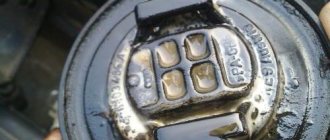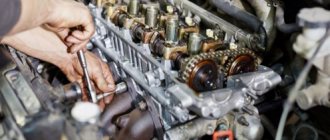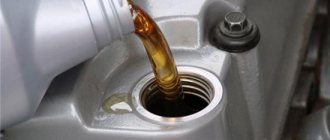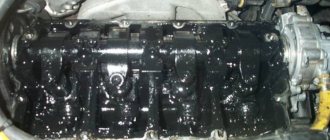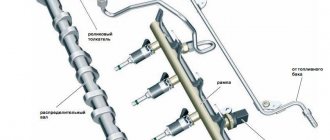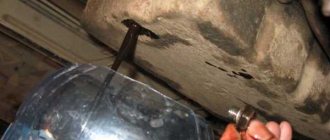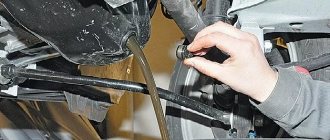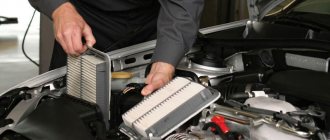Many car enthusiasts, for one reason or another, do not attach much importance to periodically checking the oil level in the engine crankcase. At the same time, one of the most important conditions when operating a car is monitoring the level of engine oil in the engine crankcase.
It is important to understand that a critical drop in oil level and the consequences for a vehicle engine can be catastrophic (increased wear of engine friction components as a result of oil starvation, engine seizure and complete failure of the internal combustion engine). In this article we will look at malfunctions that cause a sharp and intense drop in the oil level in the engine crankcase, as well as ways to eliminate them.
Where does the oil go?
In many ways, the problem with high oil consumption is associated with the design of modern engines, which have a high compression ratio, which makes it easier for gases to escape through the piston rings.
In addition, most modern engines are turbocharged, and some oil inevitably gets into the supercharger. Therefore, one of the most common reasons for a decrease in engine oil volume is its waste. The lubricant simply burns along with the fuel, depositing black soot on the walls of the pistons and cylinders.
Permissible oil consumption rates
Most often, this should not be a cause for concern, since the car manufacturer itself declares the possibility of losing a certain amount of fluid during operation of the vehicle. Usually it is enough to simply add the missing amount.
How to check the oil level:
- the car must be installed on a flat surface;
- The measurement should be carried out with the engine turned off (after waiting at least 15 minutes);
- Using a dipstick, the volume of oil in the engine is determined: the normal level should be between two marks (MIN and MAX). If it is fixed below the minimum value, you should urgently add fluid.
Is it normal to eat oil?
It turns out that modern car owners have no choice but to come to terms with the need to regularly check the oil level in the engine and add it as necessary. However, the car’s oil appetite can be somewhat moderated by doing more frequent maintenance and adhering to a calm driving style.
Normal oil consumption is considered to be approximately 0.5 percent of gasoline consumption. In other words, if during a service interval of 15 thousand kilometers your car has consumed 1200 liters of fuel, then normal oil consumption will be 400 grams of oil per 1 thousand kilometers.
Natural waste
In principle, any engine consumes engine oil “waste”. It inevitably remains on the cylinder wall after each downward stroke of the piston, and immediately burns out during the working cycle. The amount of oil not removed from the wall by the oil scraper ring depends on its properties, on the design of the engine and on the degree of wear of its cylinder-piston group and valve mechanism.
Many modern engines are structurally predisposed to “eating” oil (for example, some units of the VW Group, Subaru, etc.); often the operating manuals allow figures for its consumption of about 1.0 liters per 1000 km.
In fact, such an “oil appetite” on an unworn engine is not very common, although a warranty engineer at a dealer service station is always ready to show you exactly this figure. And yet, if on a new or almost new car you notice that the oil level in the engine has dropped sharply, immediately contact a service station - perhaps there is some emergency reason for this. By the way, a new engine with a mileage of up to 2000 - 3000 km almost always consumes more oil than a run-in unit.
Unnatural frenzy
The abnormal oil appetite of an engine with noticeable mileage is caused by wear of the cylinders, pistons and their rings, and valve seals. And if valve seals (oil seals) are, in principle, easy to replace, then replacing worn parts of the cylinder-piston group requires complete disassembly of the power unit - and this is serious work that requires qualifications from craftsmen and money from the owner.
Another option, even if the engine is not too worn out, is the so-called stuck rings. This means that due to carbon-clogged grooves in the piston, the rings lose mobility and do not fully perform their function, which is why a large amount of oil remains on the cylinder walls and burns. This problem can sometimes be solved by using flushing additives.
Summarizing
As you can see, there are a fairly large number of answers to the question of where the engine oil goes if the car doesn’t smoke. But in order to find exactly the place through which the oil is leaking among all the probable causes, you need to conduct a thorough inspection of the engine. In this case, you can do some of the work yourself, and in some cases you need to contact service station specialists. After all, without certain equipment, oil removal may not be found.
You cannot put off solving this problem for a long time, gradually adding oil to the engine to the optimal level. After all, the car owner has no idea where the poured oil leaks and where it can cause a breakdown.
And all motorists are well aware of the cost of engine overhauls. In addition, we must not forget about vehicle safety, where any breakdown can lead to an accident.
A car is a complex technical device, the operation of which depends on the coordinated functioning of all components and mechanisms. If a car's oil consumption is noticeable, a responsible car owner carries out diagnostics of the car, identifying problems in a timely manner, finding the reasons for oil consumption in the engine.
Although some maintenance work can only be performed at a service station, there are also a number of activities that must be carried out independently. In particular, it is important to check the engine oil level from time to time.
Why may the volume of oil poured into the engine decrease?
There are several reasons for engine oil consumption. Firstly, it can evaporate from the surface of cylinders that are operated at very high temperatures.
Secondly, a small amount of oil can enter (due to the lack of absolute tightness of the system) into the combustion chamber, where it ignites along with the incoming fuel mixture.
Important! New engines usually consume virtually no oil. Natural consumption appears as the internal combustion engine wears out.
On average, after traveling 1 thousand km, 100 to 300 ml of liquid can be lost. If the car is operated under load, a consumption of up to 400 ml/1000 km is acceptable. A fairly worn engine, whose mileage exceeds 150,000 km, may lose 500 ml during operation.
Natural consumption rates vary significantly depending on the type of power unit.
What is the oil consumption in a naturally aspirated engine?
Cars with naturally aspirated engines running on gasoline are the most common among all operating vehicles with internal combustion engines. For relatively new power units, the standard lubricant consumption rate is 5...30 ml per 1 thousand kilometers traveled.
Sufficiently worn engines can burn about 100 ml of oil. When operating a car in difficult conditions, you should be prepared to increase the flow rate to 500...600 ml.
Consumption rate for turbocharged engines
More and more cars are appearing on the market equipped with engines that can have from one to three turbines installed. They are characterized by both their gluttony for fuel and their high consumption of lubricating fluids (the more turbines, the higher the losses).
Even new equipment can consume about 80 ml of oil when burning every 100 liters of fuel mixture.
Oil consumption standards for diesel internal combustion engines
If during operation of a diesel engine there is a loss of up to 500 ml of lubricant for every 100 liters of fuel burned, there is no reason to worry. However, if you start spending more, there is a reason to bring the car in for diagnostics.
Extreme vehicle operating conditions also affect oil consumption. High speeds of the power unit, at which an increase in temperature is observed, lead to increased losses. Aggressive driving style or driving in mountainous areas causes more frequent addition of lubricant.
In the winter season, more oil is also consumed than in the warm season. A thick, more viscous lubricant is not able to quickly create the film required for engine operation. Therefore, it is recommended to warm up the engine for several minutes to minimize wear on the rings and cylinder block walls.
Experts advise changing the oil before the onset of cold weather. A new lubricant that has not lost its properties will help the engine operate normally in difficult conditions.
As you can see, engine oil can drain naturally. An increase in its consumption is due to a number of reasons.
Turbocharger
If symptoms such as fogging of the joints of the turbine pipes or lubricating fluid entering the intercooler appear, attention should be paid to the integrity of the gas dynamic seals of the turbocharger. These parts, by their design, are not completely sealed and partially allow gases into the central housing of the turbine. Subsequently, along with these gases, suspended oil particles are transferred to the inlet part (into the cold scroll) (i.e., in the form of fog). The greater the wear of gas-dynamic seals, the more noticeable the loss of lubricant will be.
Regular passport expense
Oil leaves the engine for various reasons. All of them can be divided into 2 groups. The reasons for the decrease in lubrication in power units may be:
- standard and certified, focused on permissible oil consumption standards;
- abnormal, caused by breakdowns of individual components.
Modern engines are characterized by established standards regarding lubricant consumption. Indicators that are within 0.1–0.3% of total fuel consumption are considered normal. For large diesel engines, the standard consumption is 0.8–3.0%. Car manufacturers try to indicate the rated lubricant consumption caused by natural waste. It is necessary to focus on these indicators so as not to sound the alarm ahead of time.
Burnout in the cylinder-piston group
For successful and durable operation of the power apparatus, lubricant invariably enters the working area of the cylinder-piston group. With intense mechanical friction and increased temperature conditions, the lubricant heats up, evaporates and burns out. This results in wasteful oil consumption. The tolerances for such natural losses are based on the type of engine and its condition.
For ease of calculation, oil consumption indicators depending on the amount of fuel are converted into a ratio with mileage. New gasoline engines consume 5–25 g of lubricant per 1000 km. Worn-out motors consume up to 100 g. 400–600 g may indicate the approaching condition of repair. The 800 g mark is considered critical.
Turbocharged gasoline engines have increased oil consumption. New engines can consume 80 g per 1000 km. Worn power units of this type absorb up to 2 liters. If the turbine is faulty, the consumption increases. Lubricant consumption in excess of 2 liters is considered critical.
The natural waste of diesel engine oil approaches the performance of a turbocharged power unit. The norm is 300–500 g per 10,000 km. The threshold of 2 liters is also considered dangerous for engine operation.
Flow due to crankcase ventilation system and turbocharger
Increased crankcase gas pressure is observed in worn-out engines. Then oil is carried to the inlet of the power unit, the loss of which is almost inevitable. During intensive use, a worn-out motor often operates at its limit. The crankcase gas velocities increase and the pressure increases. The oil has nowhere to go; it is pushed into the cylinders through fuel injection.
A similar mechanism is triggered when the turbine (turbocharger) has deteriorated. In addition, oil is also used to lubricate the turbocharger itself. This increases the standard lubricant consumption.
Abnormal lubricant consumption is often a harbinger of upcoming problems. Therefore, it is very important to pay attention in time to increased oil consumption in the engine or external leaks. A car enthusiast cannot remain indifferent when he notices oil spots under the engine. Then it is necessary to investigate in what ways the lubricant manages to escape from the engine.
Overview of the causes of engine oil consumption
Correctly diagnosing the problem is very important. Otherwise, without fixing the problem, you may soon end up with a failed power unit, the overhaul of which is fraught with large financial losses.
A car owner can easily identify and eliminate a number of problems, but serious causes of engine oil consumption require the intervention of specialists.
Easy to fix troubles
The carelessness of the car owner often leads to problems with engine lubrication.
Incorrectly selected oil
If you are not too responsible in selecting a lubricant and purchasing it at retail outlets with a dubious reputation, you can easily encounter the problem of high oil consumption.
Where does the engine oil go if the car doesn't smoke?
To answer this question, you need to study in detail all the places in the engine through which oil can leak. For this, a white sheet of paper is best suited, which should be left under the engine overnight. The next morning, by the location of the spots on the surface of the paper, you can determine the place where the leak is coming from.
It should be remembered that you need to focus on the yellow spots. After all, if the oil spots are red, then this is most likely a lubricant leak from the automatic transmission or power steering.
If no stains are found on the sheet, you need to look for leaks in the most likely areas:
You need to carefully inspect the gasket under the valve cover. If there are clear oil streaks on the outer surface of the engine, then we can assume that the problem has been found. To solve the problem, you need to replace the gaskets under the valve covers or apply sealant.
Inspection of the pan gasket. This gasket may be worn. The solution to the problem is to replace the gasket. In this case, it is important to purchase a gasket that, according to the catalog, fully matches a specific car. It is not recommended to install gaskets from another car, especially one with signs of wear. Otherwise, the oil leak story may soon repeat itself.
Penetration of the pallet body when hitting a solid obstacle. In such a situation, you either need to replace the entire pan or, if the hole is not very large, you can try to weld it. You cannot use various cold welds to eliminate the leak. Indeed, under the influence of oil pressure, such temporary sealants do not provide a long-term effect and lead to repeated failure, during which a significant amount of oil is lost.
Oil seal failure. You need to immediately pay attention to the condition of the front oil seal mounted on the crankshaft. The seals located on the camshaft can also leak. It is very difficult to visually verify that the seal is leaking. It must be remembered that the main sign of oil leakage through the oil seal may be their strong fogging and excessive oiling of the place where they are attached. If the cause of the leak is in the oil seal, it needs to be changed as quickly as possible, since engine oil can get through worn oil seals onto other engine parts.
Lubricant may be leaking from the oil pressure sensor. In this case, you need to carefully tighten the sensor using a wrench. Perhaps the sensor is not screwed in correctly at all and has a technical defect. As for sensors, to avoid a similar situation, you need to purchase only original sensors and under no circumstances run for a low price. Otherwise, you can buy a Chinese fake of low quality and a bunch of future problems.
Oil may be leaking through an oil filter that has a defective housing or is simply not tightened tightly enough. In many cars, the oil filter is installed at the bottom of the pan and can be damaged if it hits a hard object. Sometimes, the thread in the filter may simply be torn off, which prevents it from being tightened tightly enough.
The camshaft plug also deserves close attention, especially for engines with two camshafts and no distributor. Here, oil may leak out through the O-ring. In such a situation, you need to replace the plug itself. It can be made of plastic and rubber. Both options are quite acceptable, but the rubber plug will last longer. Although in practice, replacing the plastic plug is faster and easier.
Lubricant can leak through a damaged distributor o-ring. To eliminate the leak, you need to replace the O-ring and re-adjust the OZ.
It is much more difficult to eliminate a leak if oil gets into the distributor itself. The main sign of the presence of oil in the distributor is a specific crackling sound similar to the crackling sound of a bearing. To correct this situation, it is necessary to disassemble the distributor itself, clean it and replace the bearing with the seal.
Frenzy
Depending on the formula of the oil base and its basic quality, it may be more or less resistant to burning. Some oils are more prone to this.
The oil's carbon resistance depends on the quality of the additive in it, which is responsible for reducing the aging rate of the oil. The effect of aging is, in fact, the reason for its burnout.
It is worth understanding that at high speeds the lubricant will in any case begin to burn out. Thus, when traveling long distances, even without traces of smoke and soot (especially if the oil is of high quality, it leaves virtually no soot), oil is constantly lost.
Therefore, natural oil burnout, especially at high speeds, is not a big problem, since most motorists do not use their vehicles as often as a racing car.
Worn or deformed crankshaft oil seals
The release of engine oil to the outside is often associated with wear or deformation of the sealing edges of the crankshaft oil seals. The processes of rubber aging and loss of elasticity are inevitable. However, oil seals can fail much earlier than expected. The causes of premature wear are:
- use of a lubricant not provided by the engine manufacturer;
- adding untested or low-quality additives;
- a defect in the production of the oil seals themselves or the engine components.
Cases falling under these reasons will require replacement of the seals. It is important to select parts from good technical rubber that is compatible with various types of modern oils.
Where does the engine oil go: hidden reasons
Let's start with the fact that in addition to the obvious reasons for increased lubricant consumption (oil leakage), there are also indirect ones. For example, an internal combustion engine cooling system.
In simple words, a number of malfunctions in the engine cooling system, insufficiently efficient operation of this system can also lead to the so-called “oil burn”.
The reason is that insufficient heat is removed from the engine, the engine in turn becomes “hotter”, i.e. its operating temperature is forcibly increased by several degrees and the internal combustion engine operates at the upper temperature limit.
The oil recommended for use in various engines, according to its technical characteristics and tolerances, is designed to operate at lower temperatures, namely at the nominal temperature conditions of the internal combustion engine.
Accordingly, being constantly exposed to extreme temperatures, the oil intensively “burns”, and the waste products clog the oil channels, reducing the efficiency of the entire engine lubrication system.
- Oddly enough, problems in the power system can also indirectly provoke increased engine oil consumption. The problem lies in the fuel injectors, which, without proper maintenance, over time begin not to spray the fuel mixture, ensuring uniform ignition in the cylinder, but pour fuel in a stream.
As a result, uneven combustion of fuel begins and increased detonation. In turn, increased detonation leads to the appearance of microcracks in the pistons and piston rings, as well as cylinders (liners). Due to these defects, oil scraper rings do not effectively remove the oil film from the working walls of the cylinders. It turns out that oil breaks into the combustion chamber with all the ensuing consequences.
Easy to fix troubles
The carelessness of the car owner often leads to problems with engine lubrication.
Problems requiring specialist intervention
High oil consumption can also be caused by more serious reasons. To fix the problem, it is often necessary to disassemble the engine.
Worn walls of the BC
The condition of the cylinder block walls may deteriorate over time due to natural aging or the appearance of defects (such as scratches). The cylinder can also change its shape (the cross-section becomes oval).
As a result, the O-rings do not provide the necessary tightness, which leads to oil leakage. The way out of the situation is:
- or cylinder boring,
- or using less rigid rings (this is not recommended),
- or installing rings with a different geometry that compensates for the change in cylinder shape,
- or replacing the entire unit.
In any case, in this case it is impossible to do without significant financial costs.
Deformation of cylinder block gaskets or oil filter
This is almost an emergency situation. It occurs as a result of improper tightening of power bolts or unacceptable overheating of the engine. Due to the deformation of the gasket, the quality fit of the power unit parts is disrupted. This defect is detected due to traces of oil on the surface of the engine block.
Sometimes the cause is eliminated by tightening the power bolts. But more often you have to change the gasket with a complete replacement of the lubricant. Indeed, with such a malfunction, antifreeze gets the opportunity to penetrate into the cylinder area. In order not to lose the engine, you need to react quickly.
Oil leakage occurs due to unprofessional replacement of the oil filter. It may be under-screwed or over-tightened. In any of these cases, the gasket is deformed and the tightness of its fit to the engine body is disrupted. There are mechanical defects in the filter itself. Then it's better to change it.
Wear of turbine seals and bearings
When there is play in the bearings and wear of the seals, the engine oil, which is supplied under pressure to the turbines, immediately enters the combustion chamber. And if the passage of the turbine is clogged with carbon deposits, then the oil, after being sucked into the combustion chamber, ends up in the exhaust pipe. To solve the problem, you will have to repair the turbocharger.
Worn high pressure fuel pump
In some cars, fuel injection pump parts are lubricated with oil rather than diesel fuel. When fuel pump parts wear out, oil consumption increases.
Fuel system malfunctions
Without regular maintenance, the fuel injectors of a diesel internal combustion engine begin to pour fuel in a stream instead of a soft spray, which causes uneven combustion of fuel in the cylinders and detonation.
Increased detonation leads to microcracks in the pistons and piston rings and cylinders. Such defects prevent the oil scraper rings from removing the oil film from the cylinder walls evenly and completely; the remaining oil burns out in the combustion chamber.
Cylinder head gasket failure
As a result of improper engine assembly, the head is pressed unevenly against the cylinder block, causing gasket breakdown. The malfunction can be determined visually: oil streaks will be visible from under the cylinder head.
Also, if the cylinder head gasket breaks, antifreeze can enter the engine crankcase and mix with the oil. In this case, there will be an increased oil level on the dipstick and an emulsion on the dipstick and plug.
You cannot start such a motor! It is better to deliver such a car by tow truck to the place of repair and replacement of the cylinder head gasket. Be sure to also change the oil and filter, and before that, flush the lubrication system.
"Hot" engine operating mode
When not enough heat is removed from the internal combustion engine, it has to operate at the upper temperature limit and the engine remains “hot”. Due to such a forced increase in temperature, the internal combustion engine operates at the maximum permissible temperature, the oil intensively “burns”, deposits of such carbon deposits clog the oil channels, interfering with the normal operation of the lubrication system.
This problem is especially typical for modern oil scraper turbodiesels.
Crankshaft oil seal wear
This problem is easy to identify: there will be an oil puddle under the car or the exhaust will take on a bluish tint. But sometimes, for an accurate diagnosis, you will need to carefully examine the underbody of the car.
Since rubber is used to make the crankshaft oil seal, which is subject to mechanical wear over time, the best solution is to simply replace the oil seal. And also for preventive purposes, after replacing the oil seal, it is recommended to fill in new engine oil and replace the filter.
Valve seals fail
Oil seals or oil seals are one of the rather vulnerable points in the engine design. These structural parts are located in the cylinder head. The operating temperature in the area where the caps are located is approaching critical. The rubber part of the seals loses elasticity and hardens. Sealing abilities are reduced. Oil breaks into the CPG and forms deposits on the surface of the valves. The coordinated work of many components is disrupted.
Wear, overheating, coking of piston rings
In the process of natural mechanical wear of rubbing parts, oil scraper rings “get tired” before others. They receive the smallest amount of lubricant because they protect oil leakage paths. Wear of oil scraper rings leads to increased oil losses.
The elasticity of the rings is lost due to severe overheating. After this, the engine’s oil appetite increases noticeably. Sometimes very sharply and rapidly.
For many reasons, rings can become stuck or coked. The use of oil with poor cleaning properties contributes to such breakdowns. Coked rings cannot maintain proper tightness in the cylinders, and the oil finds new leakage paths.
Warping, increased wear of cylinders and valve bridges
The process of intensive engine operation can lead to deformation of the cylinders. Such processes are very typical for air-cooled engines. Crescent-shaped gaps appear between the rubbing surfaces of the rings and cylinders. They indicate to the oil where it can slip out.
Cylinder wear manifests itself in an increase in their diameter. Chips, scuffs, and scratches may also appear. Such damage creates peculiar oil pockets. The rings cannot tightly block the path of the lubricant, the amount of which in the engine invariably decreases.
A common cause is the destruction of piston inter-valve bridges. Failure occurs as a result of thermal fatigue of the rubbing elements. In this case, losses in the combustion chamber seals and wear of the piston group are observed.
Problematic oils
A high degree of viscosity of the lubricant can cause increased waste. This situation becomes especially relevant for worn-out engines.
Oil leakage is caused by its quality characteristics. The entry of counterfeit or low-quality lubricant into the motor leads to increased waste and deformation of the sealing parts. Bad oil makes its own way out of the engine.
Here are the main reasons for increased oil consumption. A caring car enthusiast will be attentive to their manifestations. Then larger problems can be avoided.
Signs and characteristics of leaks
There are three main signs by which you can understand that the engine is “eating” oil:
- A constant noticeable decrease in the lubricant level (check using a dipstick)
- The presence of dark puddles on the asphalt under the engine compartment even after the vehicle has not been idle for very long
- Blue smoke from the exhaust pipe (optional symptom)
It is a mistake to think that oil leaks only occur in older cars. Of course, the largest percentage of problems occur precisely on those vehicles that have traveled more than one hundred thousand kilometers. Problems arise due to natural wear and tear of parts or improper vehicle maintenance.
Thus, untimely replacement of consumables or neglect of this procedure can cause a large loss of lubricant.
The likelihood of experiencing excessive oil consumption on new cars increases when they fall into the hands of inexperienced or unqualified service technicians. Incorrectly selected oil (for example, the wrong viscosity) can also cause its increased consumption.
What motorists say about where engine oil goes
- The influence of crankcase gases on the fact that oil leaves the engine . If you notice excessive oil consumption, check whether crankcase gases are escaping through the air filter, as well as the crankcase gas return pipes before and after the throttle valve. Perhaps this is the problem.
- The condition of the seals affects lubricant consumption .
When valve seals become unusable, lubricant consumption will increase. If they become “stiff,” they will not be able to remove the lubricant, and it will burn. To fix the problem, it is recommended to disassemble the cylinder head. Replacing oil seals will cost 400 rubles, the cost of parts will be 100 rubles. - What is the consumption rate and how to understand that oil is leaving the engine .
When the consumption is 1,000 ml of lubricant per 1,000 km, it means there is an oil glutton. On my car, 2000 ml of oil is enough for 10,000 km. But a quiet driving mode is not for me. Lately I've been thinking that the engine needs to be repaired. It's not a matter of fuel or the fact that the "cats" are cut out. Imagine that the motor is a bath of lubricant with parts floating around. And when the oil leaves the engine, it means there is a malfunction. Perhaps the oil scraper rings or caps are worn out. In any case, the reason must be found. - Oil will still leak from the engine.
The fact is that mineral oil changes its lubricating properties after 6,000 kilometers. Synthetic after 10 thousand. Excessive oil consumption can occur for various reasons. For example, the gas pressure in the crankcase has increased, which is why some lubricant enters the combustion chamber as the piston moves to BDC.Oil scraper rings are designed to remove lubricant from the cylinder walls while moving to bottom dead center, and when moving to top dead center, part of the lubricant enters the ducts of the compression rings. There they coke and the rings are deposited. The only thing that can help is to clean the crankcase ventilation system.
Lifespan
In some cases, it is better to shorten the service interval recommended by the manufacturer (when the oil is changed, for example, every 15 thousand km). Lubricating fluid loses its performance characteristics faster if used in highly loaded engines. A liquid that has exhausted its working life can cause coking and sticking of the piston rings, after which the tightness of the cylinders decreases, the content of crankcase gases increases, and as a result, the ventilation system sends a certain amount of oil suspension to the intake part. In addition, coking contributes to an increase in the loss of lubricating fluid.
We determine without disassembling
It is difficult to accurately determine the cause of increased oil consumption without proper diagnostics. The most common method - measuring compression - will not help here. It is effective when there is significant wear of the cylinder-piston group. And if the compression rings are in perfect order, and the oil scraper rings are stuck due to coking, the compression readings will remain high, but the engine will consume liters of oil.
One of the effective testing methods is vacuum. For this purpose, a cylinder pneumatic density analyzer is used, consisting of two vacuum gauges or one combo device. To check, the spark plugs are unscrewed and vacuum gauges are installed in each cylinder in turn. First, during the stroke of the piston, the maximum vacuum in the cylinder is determined - it is called full or useful. Based on this parameter, the diagnostician draws a conclusion about the wear of the cylinder liner.
Using a second vacuum gauge, the residual (parasitic) vacuum is determined. If the cylinder liner and valves are in good condition, its value characterizes the condition of the piston rings, or rather their degree of wear, the occurrence, and breakage of the bridges on the piston. If both parameters are normal, and oil consumption is increased, then the oil scraper rings are in order, and the likely cause of oil leakage is wear of the valve stem seals.
How to decarbonize?
Liquid compounds are poured into each cylinder of a warm engine through the spark plug hole. The purpose of the drug is to soften the carbon so that it later burns without the formation of solid particles that can damage the delicate ceramic honeycomb of the neutralizer. The liquid enters the piston bottom, passes through the gaps of the compression rings, and enters their grooves in the piston. Next - onto the oil scraper rings and into the engine sump. In this case, the piston bottom is best washed. Due to difficult access, cleaning of the grooves for compression rings is poor, and oil scraper rings are even worse to clean. Sometimes you have to repeat the treatment after a short mileage.
Taking these shortcomings into account, foam compositions were developed. The method of application is the same - through the spark plug hole in the block head. But unlike a liquid foam cleaner, it fills the entire cylinder and affects not only the piston bottom, but also the combustion chamber. And if the engine has direct injection, then the fuel injector nozzle will also be washed. In terms of efficiency, foam is better than liquid, since it keeps the active substance in suspension longer.
Sources
- https://www.DriveNN.ru/journal/novosti/kuda-uhodit-maslo-iz-motora-i-kakim-dolzhen-byt-ego-normalnyy-rashod-id38177
- https://auto.24tv.ua/ru/kuda_y_pochemu_ukhodyt_maslo_yz_dvyhatelia_avto_esly_uroven_upal_n7045
- https://autoexpert174.ru/uhodit-maslo-dvigatelja-prichiny/
- https://motoroilclub.ru/diagnostika-i-remont/uhodit-maslo-iz-dvigatelja.html
- https://ProMotornoeMaslo.ru/pro-motornoe-maslo/kuda-uhodit-maslo-iz-dvigatelya/
- https://KrutiMotor.ru/uhodit-maslo-iz-dvigatelya-prichiny/
- https://www.dieselkraft.by/poleznaya-informatsiya/kuda-ukhodit-maslo-iz-dizelnogo-dvigatelya-12-veroyatnykh-prichin.html
- https://rad-star.ru/pressroom/articles/maslo-ukhodit-iz-dvigetelya/
- https://www.zr.ru/content/articles/925418-kak-pobedit-maslozhor-i-ego-posledstviya/
